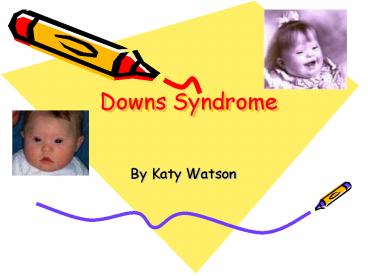Downs Syndrome - PowerPoint PPT Presentation
1 / 8
Title:
Downs Syndrome
Description:
Individuals with Down syndrome are usually smaller than their non-disabled peers. ... Made for the National Down Syndrome Society, the Everyone Counts Teaching ... – PowerPoint PPT presentation
Number of Views:1302
Avg rating:3.0/5.0
Title: Downs Syndrome
1
Downs Syndrome
- By Katy Watson
2
History
- Before the early 19th century many people
believed that people with down syndrome had not
been identified, unless by the art, literature
and science. - In 1866, English physician, John Langdon Down
published the correct description of Down
syndrome. - After his work he became the father of the
syndrome. - 1959, French physician Jerome Lejeune figured out
the syndrome was a chromosomal abnormally.
3
What is Downs Syndrome
- A learning Disability caused by cells not
dividing correctly during pregnancy. Giving a
child 47 instead of 46 chromosomes. Resulting in
an extra partial or complete 21st chromosome. - The added chromosome affects the order of the
brain development.
4
Characteristics
- There is more the fifty different
characteristics, these are just the common. - Low muscle tone, An excessive ability to extend
the joints. Individuals with Down syndrome are
usually smaller than their non-disabled peers. - Flat facial profile, a somewhat depressed nasal
bridge and a small nose - Upward slant to the eyes, Visual problems such as
crossed eyes and far- or nearsightedness are
higher in those with Down syndrome, Small skin
folds on the inner corner of the eyes - An abnormal shape of the ear, as are mild to
moderate hearing loss and speech difficulty - A single deep crease across the center of the
palm , fifth finger has one flexion furrow
instead of two, Excessive space between large and
second toe - Enlargement of tongue in relationship to size of
mouth - Children with Down syndrome frequently have
specific health-related problems, most common is
Heart Defects. A lowered resistance to infection
makes these children more prone to respiratory
problems
5
Incidences
- Approximately 4,000 children with Down syndrome
are born in the U.S. each year. - 1 in every 800 to 1,000 live births.
- Although parents of any age may have child with
Down syndrome, the incidence is higher for women
over 35. - Most common forms of the syndrome do not usually
occur more than once in a family.
6
Early Intervention and Schooling
- Shortly after a diagnoses of Down syndrome is
confirmed, parents should be encouraged to enroll
their child in an infant development/early
intervention program. - These programs offer parents special instruction
in teaching their child language, cognitive,
self-help, and social skills, and specific
exercises for gross and fine motor development. - Continuing education, positive public attitudes,
and a stimulating home environment have also been
found to promote the child's overall
development. - Due to these individual differences, it is
impossible to predict future achievements of
children with Down syndrome. - Teaching tasks in a step-by-step manner with
frequent reinforcement and consistent feedback
has been proven successful. - For hard of hearing children, a child may uses
forms of sign language. - Inclusion with either a paraprofessional, or
being taken out for one on one teaching in
certain subject area. - In a study research found that the inclusion
proved to beneficial because there was more time
for conferences between teachers, parents, and
support. - Must have teachers that are willing to modify
class, and need to utilize hands on learning
materials. - Made for the National Down Syndrome Society, the
Everyone Counts Teaching Acceptance and
Inclusion. Teaches both children with or without
disabilities. The kid includes lesson plans,
posters, videos, and a booklet about inclusion,
for age range k-6. This program was piloted in
21 different classroom in the north east states.
A third grader wrote Having a disability means
that you can have friends just like other people.
It means that someone with a disability can be
your best friend. You may not sound the same as
some people, but you are just as important as all
the other people in the world.
7
Environment Adaptations
- Child with downs syndrome may have eating
difficulties too. - To help the child may need to use a sippy cup
longer - May need to have help using a spoon
- Their food may need to cut up in to small pieces
- Learning centers should have accommodations too.
- In the reading center there should be books about
children with disabilities along with regular
books. - Dramatic play should have dolls with
disabilities, along with different ethnicities. - Block/building center should have soft sponge
like blocks so if the child does not have muscle
control the block will not hurt if they get
thrown. There should also be blocks with holes
for the child to grasp on. - Like multiculturalism there should be pictures of
children with disabilities around the room and in
the bathroom. The other children along with the
child with downs syndrome will be able to look at
the pictures and recognize that some one close
looks just like the picture. - If the child has some vision loss, a teacher may
have to either write in large print or use a more
notice able color - The child may be hard of hearing, so some labels
on the toys with symbols and the ASL sign should
be included through out the classroom. - If the child in nonverbal or not speaking yet,
the teacher should encourage the child to use
sign language, and have the teacher use the
correct pronunciation of words when the child
signs - Activities that is developmentally appropriate
for that child.
8
Resources
- National Down Syndrome Society
- http//www.ndss.org/content.cfm?fuseactionInfoRe
s.Generalarticlearticle2 - NICHCY
- http//www.nichcy.org































